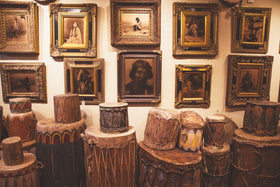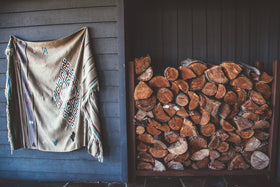Navajo Weavings: Visual. Functional. Historical.

Navajo weaving and textiles date to the 17th century, rooted in the cultural traditions of the Navajo (Diné) people of the American Southwest. The origins of Navajo weaving are closely tied to their interactions with the Pueblo peoples, from whom they learned the art of weaving on upright looms after migrating into the region around the 1400s. Initially, the Navajo adopted weaving to create utilitarian items such as clothing and blankets, influenced by Pueblo cotton-based textiles. However, following the arrival of Spanish settlers in the 16th and 17th centuries, the Navajo were introduced to sheep, specifically the Churro breed, which transformed their textile production. By the mid-1600s, Navajo weavers began using wool, shifting their craft toward the durable, warm textiles for which they would become renowned, including rugs, saddle blankets, and wearing blankets.
 The Blanket Weaver - Edward Curtis
The Blanket Weaver - Edward Curtis
The materials used in Navajo weaving evolved over time, reflecting both environmental adaptation and cultural exchange. Early Navajo textiles were made from hand-spun wool from Churro sheep, prized for its long, strong fibers and natural luster. The wool was meticulously cleaned, carded, and spun into yarn using a spindle, and then woven on vertical looms, a process that remained labor-intensive and highly skilled. For wearing blankets—often called "chief blankets" due to their association with status—and saddle blankets, weavers prioritized tightly woven, durable fabrics that could withstand daily use. Rugs, which emerged later as a distinct category, particularly after the 1880s when trade with Anglo-Americans increased, showcased thicker, more intricate designs.

Natural Dye Chart
Dyes played a crucial role in the aesthetic development of Navajo textiles, transitioning from natural to synthetic sources over centuries. In the pre-contact and early historic periods, Navajo weavers relied on natural dyes derived from local plants, minerals, and insects. For example, indigo (traded from Mexico) produced deep blues, while cochineal insects yielded vibrant reds. Yellows came from plants like rabbitbrush, and blacks were achieved through combinations of sumac, piñon pitch, and iron-rich clay. These natural dyes created the muted, earthy tones characteristic of early wearing blankets and saddle blankets. By the mid-19th century, however, the introduction of commercial aniline dyes via trade with Americans brought brighter, more varied colors like synthetic reds, oranges, and purples, which became prominent in the bold geometric patterns of Navajo rugs during the "Classic/ Late-Classic" (1800–1870s) and "Transitional" (1870s–1890s) periods.
Navajo Child’s Classic Blanket, with homespun raveled yarn, and Indigo
The evolution of Navajo weaving reflects both continuity and adaptation, shaped by cultural resilience and external influences. Wearing blankets, originally functional garments worn over the shoulders, became symbols of wealth and prestige, often traded across tribes and later to Anglo settlers. Saddle blankets, designed for practical use under horse saddles, showcased simpler patterns but similar durability. Rugs, however, marked a significant shift in purpose, emerging as a commercial product in the late 19th century when the Navajo were confined to reservations and encouraged by traders to produce floor coverings for non-Native markets. Despite challenges like the forced Long Walk of 1863–1868 and the imposition of machine-made goods, Navajo weavers preserved their craft, adapting designs—like the iconic "eye-dazzler" patterns—while maintaining traditional techniques. Today, Navajo textiles remain a celebrated art form, embodying a legacy of innovation, identity, and mastery of wool, dye, and loom.
Navajo Single Saddle Blanket with Eye Dazzler Design

Navajo Weaving Cultural Region Chart
View Cisco's Collection of Antique Navajo & Southwest Weavings






